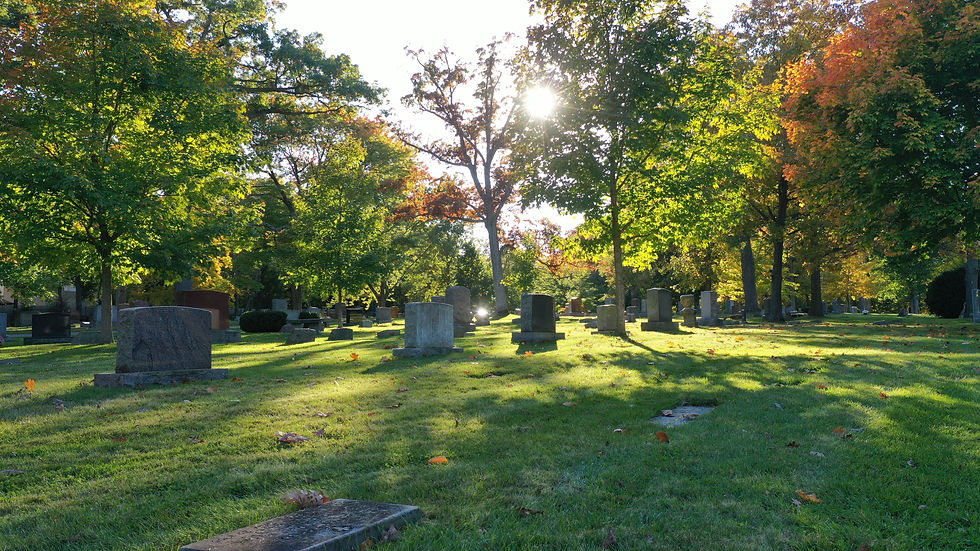Beauty and History: The Lake Forest Cemetery
- Sam Sosani
- Oct 30
- 4 min read
By Sam Sosani
The Gothic stone-arch opening of the Lake Forest Cemetery leads visitors into a space where loved ones lay at rest and where the living pay their respects. Visitors appreciate the beauty exhibited in the headstones, monuments, mausoleums, and greenery.
It is difficult not to notice the visually appealing architectural details and masonry that encompass the cemetery, but there is more than just beauty; there is history. The Lake Forest Cemetery is a historic landmark, and there are many parts that yield insights and learning from the emblems on the gravestones to the history of those buried.

“The cemetery holds great historical and cultural value in the memorials that help provide insight into past generations," says Sexton Phil Alderks.
Phil Alderks, the Lake Forest Cemetery Sexton who has worked there for 26 years, feels strongly about the importance of visiting the grounds.
“The cemetery has been well managed by the Cemetery Commission to be a place of remembrance, a safe place to process grief, and a place for spiritual reflection,” he said. “The cemetery holds great historical and cultural value in the memorials that help provide insight into past generations. It’s also a place of introspection where one can come to appreciate the present moment and the value of life as one encounters the reminder of our mortality.”
The Lake Forest Cemetery was the first planned public work in town. The first recorded burial was on Aug. 14, 1882 for Martha McClanahan, even though the cemetery site was originally selected by the trustees of the Lake Forest Association in 1857. One monument at the cemetery is particularly impactful. Lake Forest citizens funded the building of a monument for Samuel Dent. He was born enslaved in Tuscumbia, Ala. in 1835, but he liberated himself in 1862. He was an African-American citizen buried amongst predominantly white citizens at the Lake Forest Cemetery. Dent was recognized as a historic part of the community as he had a livery service to take many Lake Forest residents through the windy roads to and from the Chicago & North Western train station. When he passed in 1890, he was remembered as a leader of the African Methodist Church, an outgoing community member, and a spirited individual.

The stone arch is a beautiful entry point into Lake Forest Cemetery.
Visiting the cemetery can be a wonderful place to slow down during one’s busy life. In the Memorial Gardens, a visitor can take in the tranquil sounds of the water flowing in the fountain, or while walking around, a visitor can listen to the rustling of the trees or maybe even wildlife snacking as they rest above on the sturdy branches.
Alderks pointed out that the cemetery can be a serene setting no matter the season. In the spring and summer, captivating flowers and trees are in bloom, bringing color and life to the space. In the cooler seasons there are still aspects to enjoy, such as the autumn leaves on the trees and the winter wreaths.
“It’s a very beautiful space—the nature, the monuments, the landscape,” said Dr. Rebecca Graff, a Lake Forest College Associate Professor of Anthropology. “I enjoy walking through and seeing the changing seasons and learning about the city’s history when visiting those whose names I see in the town and on the campus buildings.”

For more than a decade, Dr. Rebecca Graff has assigned Lake Forest College students to visit a cemetery of their choosing.
She recounted that once in the early morning when she was taking a stroll, she saw a mother deer with her fawn. Encounters with wildlife at the cemetery emphasize the unpredictable nature and beauty of the setting by Lake Michigan.
Graff is especially intrigued in cemeteries from an archaeological viewpoint because it can be insightful and educational.
“Archaeologists are interested in material culture—the things people make and use to make meaning and interact with each other. Cemeteries have a lot of that and, given the sort of information on a grave marker, they also allow the viewer to start to understand the beliefs, values, and relationships as evidenced through these final burial sites.”
Since 2014, as part of her Introduction to Archaeology class, Graff has assigned Lake Forest College students to visit a cemetery of their choosing. It is a well-known exercise among archaeologists that help students to engage and interact with the environment altered by humans. The cemetery monument is especially useful because of the dateable aspect of the grave markers, since most items we come across in daily life are not. Graff ensures that her students conduct their research with respect and care for those using the cemetery as a place to mourn the deceased.

Cemetery markers can reveal much to Dr. Graff's students.
“I have my students look at cemetery markers to understand demographic trends, religious affiliation, ethnicity and racial identity, and even things like membership in fraternal orders and other organizations to get a sense of what individuals and communities value and believe in at a particular moment in time,” Graff said.
The little-visited Section E may be a part that visitors may want to check out. Alderks indicated that it is off the main loop, and many visitors are even unaware that it exists.
“It’s a different style than the traditional main part of the cemetery,” he said. “In Section E all the memorials are flush with the ground, so it feels more park-like than cemetery-like. It is quieter and less traveled.” For more information, visit https://cityoflakeforest.com/departments/cemetery/





